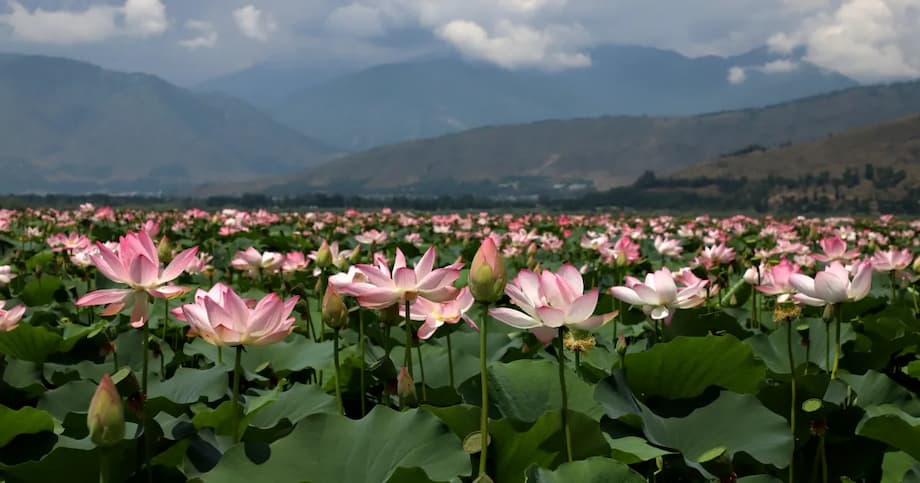Kashmir’s Wular Lake Sees Lotus Bloom After Three Decades, Reviving Livelihoods and Hope
The return of lotus flowers to Wular Lake marks a turning point for local communities, ecology, and Kashmir’s cultural heritage.
In the summer of 2025, the tranquil waters of Wular Lake in north Kashmir erupted in a sea of pink as lotus flowers bloomed for the first time in over thirty years. This remarkable event, witnessed between the towns of Bandipora and Sopore, has brought relief and optimism to thousands of families who once depended on the lake for their livelihoods. The resurgence of the lotus, locally known as nadru, signals not only an environmental recovery but also a revival of cultural traditions and economic opportunities for the region.
- Kashmir’s Wular Lake Sees Lotus Bloom After Three Decades, Reviving Livelihoods and Hope
- How Did Wular Lake Lose Its Lotus Flowers?
- Restoration Efforts: How Did the Lotus Return?
- Economic and Social Impact: Livelihoods Restored
- Cultural and Ecological Significance of the Lotus
- Tourism and the Green Economy: New Opportunities
- Challenges Ahead: Sustaining the Revival
- Key Points
Wular Lake, one of Asia’s largest freshwater bodies, had lost its famed lotus beds after catastrophic floods in 1992 buried the lakebed under thick layers of silt. For decades, the community watched as their source of income and a cherished part of Kashmiri cuisine vanished. Now, thanks to sustained conservation efforts, the lotus has returned, and with it, a sense of hope and renewal.
How Did Wular Lake Lose Its Lotus Flowers?
Wular Lake’s decline began in September 1992, when devastating floods swept through the Kashmir Valley. Water from the Jhelum River surged into the lake, carrying vast amounts of silt and debris. This sediment settled across the lakebed, choking aquatic plants, including the lotus, and disrupting the delicate ecosystem. The once-vibrant lake, which spanned over 200 square kilometers in the early 20th century, began to shrink and stagnate.
For local residents, the loss was deeply personal. Abdul Rashid Dar, a lifelong resident and lotus stem harvester, recalled how he used to collect nadru with his father as a child. He believed the lotuses were lost forever. The disappearance of the lotus meant the end of a traditional occupation and a vital ingredient in Kashmiri cuisine. Families who had relied on harvesting lotus stems, water chestnuts, and fishing were forced to seek other means of survival.
Environmental degradation compounded the problem. Over the years, unchecked siltation, pollution from agricultural runoff, illegal encroachments, and the expansion of willow plantations around the lake further reduced its size and water quality. By 2007, Wular Lake had shrunk to just 86 square kilometers, less than half its original area. The lake’s biodiversity suffered, and the seasonal bloom of nadru became a distant memory.
Restoration Efforts: How Did the Lotus Return?
The turnaround began in 2020, when the Wular Conservation and Management Authority (WUCMA), under the Jammu and Kashmir government, launched an ambitious restoration plan. The primary focus was on dredging—the laborious process of removing accumulated silt and debris from the lakebed to restore water depth and flow. Over 7.9 million cubic meters of silt were removed, and more than 2 million willows were uprooted to prevent further siltation.
Mudasir Ahmad, a zonal officer with WUCMA, explained that lotus seeds had remained dormant, buried deep in the silt. Only after extensive dredging could sunlight reach the lakebed, allowing these seeds to sprout. The authority also dispersed new lotus seeds in cleared areas to encourage regrowth. Controlled sowing of nadru, about 20 to 30 percent of what naturally grows, was carried out to support the revival.
Community involvement was crucial. Local residents joined the restoration efforts, participating in awareness campaigns and helping to plant aquatic vegetation. The project also included constructing retention basins along major streams to prevent future silt and waste from entering the lake. These combined efforts paid off: by 2024, small patches of lotus began to reappear, and in 2025, the lake witnessed a full-scale bloom covering nearly 3 square kilometers.
Chief Conservator of Forests, Irfan Rasool, highlighted the significance of this achievement:
“The return of lotuses proves that the lake’s ecological health is improving. Over 80 lakh cubic metres of silt have been removed so far. This not only restored the lake’s depth and water-holding capacity but also allowed sunlight to reach the lakebed, helping dormant lotus roots grow again.”
The restoration has also improved water quality, encouraged the return of migratory birds, and revived other aquatic plants like water chestnut and weed beds used as cattle fodder.
Economic and Social Impact: Livelihoods Restored
The return of the lotus has had a profound effect on the local economy. Nadru, the edible stem of the lotus, is a prized delicacy in Kashmiri cuisine, featured in dishes such as Nadru Yakhni and Nadru Monje. Before the floods, harvesting nadru provided seasonal employment to hundreds of families, especially during the harsh winter months when other work was scarce.
Harvesting lotus stems is a labor-intensive process. Farmers must wade or dive neck-deep into the water to extract the stems, which are then bundled and sold in local markets. Top-grade nadru from Wular Lake is renowned for its taste and color, fetching high prices both domestically and internationally. In local markets, nadru sells for Rs. 250 to Rs. 300 per kilogram, offering a significant source of income for families living around the lake.
For many, the return of the lotus means more than just economic relief. It represents the restoration of a way of life and a reconnection with cultural traditions. Women who once carried baskets of lotus stems on their heads are wading through the shallow waters again, and elderly fishermen are training younger family members in traditional harvesting techniques. The sounds of oars hitting the water and people working along the lake’s edge have returned, signaling a revival of community spirit.
Showkat Ahmad, a conservation worker from SK Bala village, described the emotional impact:
“This is the first time I have seen lotus stems in Wular Lake in decades. Last year, farmers took a token amount, but this year the government is expanding the amount that is allowed to be picked. For many families, the return of the lotus blooms means a restored livelihood.”
The upcoming harvest is expected to inject significant income into the local economy, marking a turning point for green livelihoods in the region. The success of lotus restoration in Wular Lake is now seen as a model for participatory conservation, where ecological health and community well-being are closely linked.
Cultural and Ecological Significance of the Lotus
The lotus holds deep cultural and symbolic meaning in Kashmir and across South Asia. In Hinduism, the flower symbolizes spiritual enlightenment, purity, and prosperity. In Kashmiri culture, nadru is not just food but a part of family traditions, festivals, and local art. The return of the lotus has allowed families to prepare traditional dishes the way their grandmothers did, restoring a cherished aspect of daily life.
Ecologically, Wular Lake is a wetland of international importance, designated under the Ramsar Convention. It plays a crucial role in flood control, water purification, and biodiversity conservation in the Kashmir Valley. The lake supports a wide range of aquatic life, including fish, water chestnuts, and migratory birds. The revival of lotus beds has improved habitat quality, attracting rare bird species such as the Long-tailed Duck, Smew Duck, Great Bittern, Marbled Teal, and the endangered Pallas’s Fish-eagle.
Fatima, a resident of Garoora village, expressed what the lake means to the community:
“Wular is not just a lake. It’s part of who we are. Now that the sounds of life have returned—oars hitting the water, people laughing, working—it feels like our home is alive again.”
The lotus bloom is also seen as an indicator of the lake’s improving health and biodiversity. It demonstrates that environmental restoration is not just about land and water but also about restoring connections to tradition, livelihoods, and identity.
Tourism and the Green Economy: New Opportunities
The breathtaking sight of lotus blossoms has not gone unnoticed by visitors. Wular Lake, already known for its scenic beauty and proximity to the Harmukh mountains, is becoming a highlight for eco-tourism in Jammu and Kashmir. Tourists are flocking to the lake to experience boat rides on traditional shikaras, gliding through fields of pink lotus petals and enjoying the peaceful atmosphere.
The revival of the lake has boosted the local economy beyond just lotus harvesting. Boat operators, guesthouses, and artisans are benefiting from increased tourism. Eco-tourism activities, such as birdwatching and guided walks along the lake’s wetlands, are attracting nature lovers and supporting sustainable travel. The local government and environmental groups have implemented measures to keep the lake clean and prevent further pollution, ensuring that tourism remains eco-friendly.
Travelers can also combine a visit to Wular Lake with cultural experiences in nearby Srinagar, such as exploring the old city or visiting the Shankaracharya Temple. The restoration of Wular Lake is helping to position Kashmir as a destination for responsible tourism, where natural beauty, cultural heritage, and environmental stewardship go hand in hand.
Challenges Ahead: Sustaining the Revival
Despite the remarkable recovery, Wular Lake’s future remains fragile. The threats that led to its decline—illegal encroachments, waste dumping, pollution, and the impacts of climate change—still linger. Experts and local residents stress that sustaining the progress will require ongoing ecological monitoring, strict enforcement of environmental regulations, and continued community participation.
Mudasir Ahmad of WUCMA emphasized the importance of vigilance:
“We lost this beauty once because of our mistakes. We shouldn’t let that happen again.”
The government is planning further investments in cleanup and conservation to establish Wular Lake as a center for eco-tourism and green livelihoods. Retention basins are being constructed to prevent future siltation, and awareness campaigns are ongoing to educate the public about the importance of protecting the lake’s fragile ecosystem.
Local fishermen and farmers believe that maintaining the lake’s cleanliness is key to sustaining the lotus bloom and the economic benefits it brings. The story of Wular Lake’s revival is a testament to what can be achieved when communities, authorities, and environmentalists work together toward a common goal.
Key Points
- Lotus flowers have returned to Wular Lake in Kashmir after more than thirty years, following extensive restoration and dredging efforts.
- The 1992 floods buried the lakebed under silt, wiping out lotus plants and devastating local livelihoods.
- The revival of the lotus, or nadru, is restoring traditional occupations, boosting the local economy, and reviving Kashmiri culinary traditions.
- Wular Lake’s recovery is attracting tourists, supporting eco-tourism, and highlighting the importance of sustainable travel in the region.
- Ongoing conservation efforts and community involvement are essential to protect the lake from future threats such as pollution, encroachment, and climate change.
- The lotus bloom is seen as a symbol of hope, resilience, and the restoration of both nature and cultural heritage in Kashmir.












